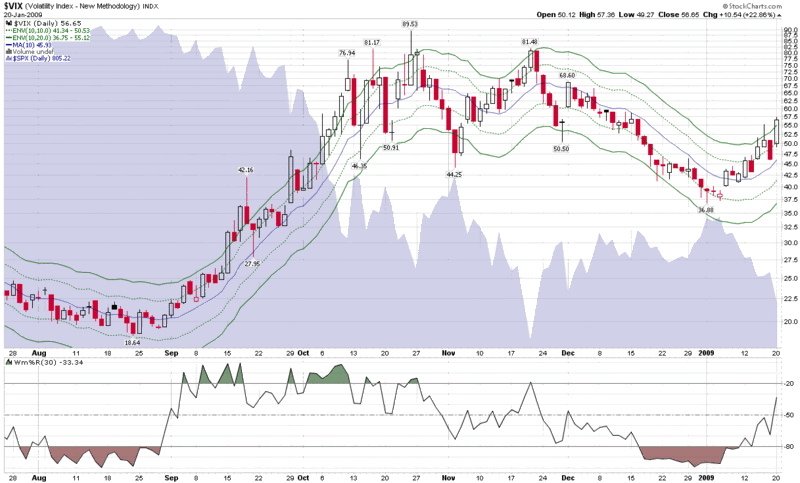What the VIX Thinks About Tuesday’s Breakdown
I know I shouldn’t be referring to the VIX as a sentient being, but I get so many questions along the lines of “what does the VIX think about…?” that I hope I can be excused for an occasional anthropomorphic slip of the keyboard.
In any event, I think the equity markets are at an important inflection point at the moment, with large commercial banks across the globe breaking down and starting to pull the major indices with them. Momentum is decidedly in the bearish camp and while today’s volume was of the fair to middling variety, we appear to be as close as one or two trading days away from the type of meltdown that could make November a fond memory.
Of course there are several possible scenarios and not all of them are bearish.
The chart below is one of my basic VIX charts and uses 10% and 20% moving average envelopes to bracket a 10 day simple moving average. The VIX closed 23.3% above the 10 day SMA, clearly at overbought levels, but as September and October showed, this is no guarantee we have hit a reversal point.
I also like to study the VIX relative to various historical volatility measures for the SPX. This too suggests an extremely extended VIX, with 10, 20 and 30 day historical volatility currently all residing in the 33-37 range.
The ever popular VIX:VXV ratio, which considers some elements that are analogous to the VIX term structure, is more neutral, with a slightly bullish reading of 1.032.
When I looked for historical data points that closely resemble the current situation I struggled to find analogous data. Only two periods come close to matching the present: October 2007, just when the markets were putting in a top; and July 1993, when the markets were slowly running out of steam, prior the bearish 1994 that preceded the great bullish leg from 1995-1999.
All things considered, my best guess is that the VIX is soon to begin suffering from oxygen deprivation and is not likely to climb much higher than the current altitude, providing some relief to the markets and keeping the SPX above the 770 level – perhaps even establishing 800 as the new SPX floor. The large pool of cash on the sidelines is sure to be tempted at current levels, but will not likely chase equities until there are some more convincing signs of a bottom forming. The next week or two could well determine whether the balance of the first half of 2009 is bullish or bearish.

[source: StockCharts]


8 comments:
At least this guy at thinkingtrades is thinking the opposite.
Is there a standard measure of volatility for Treasuries ? I have the feeling it is up.
If there is a 'standard measure' of volatility for Treasuries, then I am not aware of it.
The data I look at, however, show historical volatility in Treasuries moving up and implied volatility in the likes of TLT also starting to rise.
Cheers,
-Bill
Thanks for the answer, Bill.
Is your time series deep enough to confirm/deny my thought, that Treasury volatility is "unprecedented " ?
MutantDog
Bill, I thought your response suggests that the T-volatility measures you look at aren't and haven't been at extremes -- right?
And what about expectations/fear short term vs., say, one year?
Regarding U.S. Treasury volatility, there are different measures and instruments of different duration, but I can go back more than a decade.
Volatility first peaked during the second week in October and then surpassed that level to set a new all-time high during the latter half of November and into the first half of December.
Current volatility (HV, IV, ATR) does not compare to what we saw toward the end of last year.
Bill
do you think VIX drop too much today
Given the rally in the financials, I don't the VIX has fallen too far today.
While the VIX is at 47.68 as I type this, this is up from a close of 46.11 on Friday.
Post a Comment